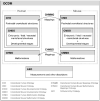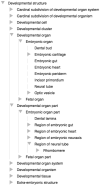The ontology of craniofacial development and malformation for translational craniofacial research
- PMID: 24124010
- PMCID: PMC4041627
- DOI: 10.1002/ajmg.c.31377
The ontology of craniofacial development and malformation for translational craniofacial research
Abstract
We introduce the Ontology of Craniofacial Development and Malformation (OCDM) as a mechanism for representing knowledge about craniofacial development and malformation, and for using that knowledge to facilitate integrating craniofacial data obtained via multiple techniques from multiple labs and at multiple levels of granularity. The OCDM is a project of the NIDCR-sponsored FaceBase Consortium, whose goal is to promote and enable research into the genetic and epigenetic causes of specific craniofacial abnormalities through the provision of publicly accessible, integrated craniofacial data. However, the OCDM should be usable for integrating any web-accessible craniofacial data, not just those data available through FaceBase. The OCDM is based on the Foundational Model of Anatomy (FMA), our comprehensive ontology of canonical human adult anatomy, and includes modules to represent adult and developmental craniofacial anatomy in both human and mouse, mappings between homologous structures in human and mouse, and associated malformations. We describe these modules, as well as prototype uses of the OCDM for integrating craniofacial data. By using the terms from the OCDM to annotate data, and by combining queries over the ontology with those over annotated data, it becomes possible to create "intelligent" queries that can, for example, find gene expression data obtained from mouse structures that are precursors to homologous human structures involved in malformations such as cleft lip. We suggest that the OCDM can be useful not only for integrating craniofacial data, but also for expressing new knowledge gained from analyzing the integrated data.
Keywords: craniofacial development and malformation; data integration; knowledge representation; ontologies.
© 2013 Wiley Periodicals, Inc.
Figures







References
-
- Ashburner M, Ball CA, Blake JA, Botstein D, Butler H, Cherry JM, Davis AP, Dolinski K, Dwight SS, Eppig JT, Harris MA, Hill DP, Issel-Tarver L, Kasarskis A, Lewis S, Matese JC, Richardson JE, Ringwald M, Rubin GM, Sherlock G. Gene ontology: tool for the unification of biology. The Gene Ontology Consortium. Nat. Genet. 2000;25:25–29. - PMC - PubMed
-
- Baldock RA, Dubreuil C, Hill B, Davidson D. Bioinformatics Databases and Systems. Kluwer Academic Press; 1999. The Edinburgh Mouse Atlas: Basic Structure and Informatics; pp. 102–115.
Publication types
MeSH terms
Grants and funding
LinkOut - more resources
Full Text Sources
Other Literature Sources
Medical

